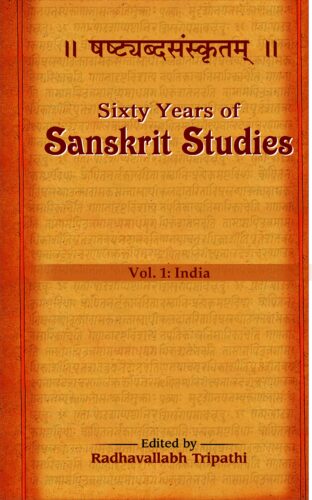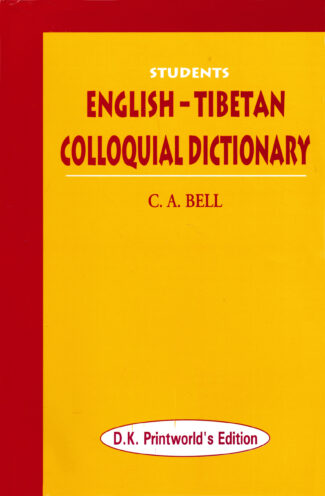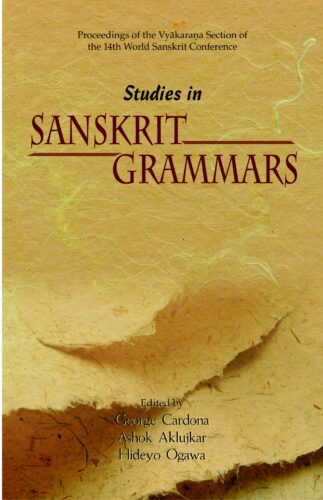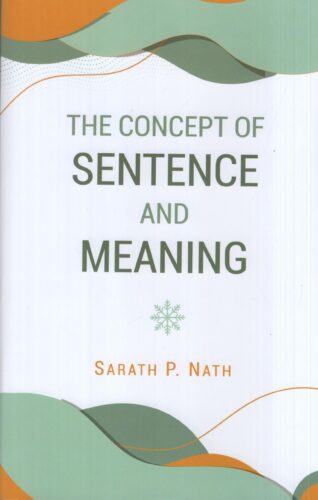Showing 41–50 of 59 results

Sarada script has a pride of place among the Indian scripts. Though an alphabet of Kashmir par exellence, it remained for several centuries a popular script of north-western India and an extensive area around it. This book deals with the development of this script and its descendants, the Devasesaa and Takari scripts.
Among the Indian scripts the Sharada script has a pride of place. Though an alphabet of Kashmir par excellence it remained for several centuries a popular script of an extensive area of north-western India including Afghanistan, Gandhara or north-western Pakistan, the Darad territories of Gilgit, Chilas and Chitral, Ladakh, Jammu, Himachal Pradesh and Delhi. The epigraphic and literary records written in the Sharada script that have surfaced in these regions have thrown welcome light on many facets of the history and culture of the area of their provenance. Nearly the entire extant manuscripts of Sanskrit works including those on science, mathematics and erotics besides some old Kashmiri texts are written in this script. The Sharada alphabet was replaced in the 13th century by its descendant, the Devashesha, which in turn gave rise to the modern alphabet of Takari. The epigraphic, literary and other valuable documents of Himachal Pradesh available are mostly written in Devashesha and Takari. But it is sad that the number of scholars having a sound knowledge of the Sharada and Takari scripts is extremely small. There is every apprehension of the complete loss of these two scripts unless serious measures are taken to disseminate the knowledge under the guidance of the epigraphy stalwart to our younger generation of scholars. The entire study of the present work is based on original records and is comprehensively illustrated by palaeographic tables and charts prepared from published facsimilies, photographs, and original inscriptions and manuscripts. To give an idea of the records written in these two scripts, printed photographs of the inscriptions, manuscripts, documents, etc. have been given at the end of the book. It is hoped that the book would serve as a guide and an aid for the scholars interested in the study of the important and valuable records written in Sharada and Takari scripts which are otherwise preserved in museums and libraries in India and abroad.
The experiences and knowledge from our past are recorded in manuscripts which have been handed down to us over several thousand years. The Government of India, through the Department of Culture, took note of the importance of this vast tangible heritage and, in order to preserve and conserve as well as to make access to this wealth easy, established the National Mission for Manuscripts (NMM). In order to disseminate the knowledge content of manuscripts, the Mission has taken up several programmes such as lectures, seminars, and workshops. The Mission publishes the proceedings of the above-said programmes under the following series: “Samrakshika” (on conservation), “Tattvabodha” (comprising lectures based on manuscripts delivered by eminent scholars), Samikshika” (research-oriented papers presented in the seminars), and “Kritibodha” (transcribed and edited texts prepared at advanced level manuscriptology workshops conducted by NMM).
NMM has taken up a project for publishing rare and unpublished manuscripts in three forms: (a) facsimile, (b) critical edition with annotation, and (c) critical edition with translation. This series has been named as “Prakashika”.
This critically edited volume of the Shivajnanabodhabhashyam is a commentary by Shivagrayogin, an acclaimed authority on Shaiva Siddhanta, on the Shivajnanabodham of Meykandadeva, another great exponent of Shaivaism. It is the most authentic, canonical and methodical work on Shaiva Siddhanta. It stands as a mark of classical scholasticism in the Indian philosophical system. It is 39 in the Prakashika Series.

The volume aims at sharpening the skills of translating the Sanskrit philosophical texts so as to retain fundamental concreteness, basic dynamics and original flavour. The volume particularly highlights the use and significance of prefixes in the backdrop of leading Indian philosophical texts.
This volume attempts to present a dynamic approach to translating Sanskrit philosophical texts while emphasizing on keeping certain principles in mind when rendering Sanskrit philosophical texts such as: the fundamental concreteness, the basic dynamics, the resultant ambiguity and the necessary congruence of the term in question with the specific context in which it is introduced. In this context, it particularly throws light on the use and significance of prefixes, particularly of propositions used as prefixes, in Sanskrit philosophical terminology. It also examines the basic problem in dealing with prefixes; their relation to the verbal roots to which they are attached. It studies the philosophical texts of various leading schools and systems including Vedanta, Mimamsa, Samkhya, Yoga, Nyaya, Vaisesika, Buddhism and Jainism, to examine the compound-terms in them and the mental operations which are grammatically and philosophically expressed. Study of the variation of terms brought about by the application of prefixes is intended. It argues that the prefixes throw into relief, by the different modes of their application, the specific bent of the systems themselves. They have retained the motional and emotional significance, which they apparently once had, at the earliest stage. The book also takes up some vital questions, such as, whether the prefix or the noun is the essential bearer of the meaning.
The volume is a well-researched study of the use of language in Sanskrit philosophical texts. It will prove useful to scholars and students of Indology, particularly those concerned with Sanskrit language and philosophy.

The individual papers published in this compendium present a comprehensive view of the status and trends of Sanskrit studies in India and related developments over the last sixty years. This state-wise systematic presentation covers various aspects of Sanskrit teaching, research and publications as also the diverse initiatives taken by the state governments, etc. for promotion of Sanskrit Studies in the recent past.
Sanskrit was born and nurtured in India and in course of time became the mother of many languages worldwide besides a host of regional languages, it continues to be a source of inspiration, treasure trove of knowledge and a symbol of universal brotherhood. These virtues of the great language need to be taken good care of.
There is hardly any region or district in India where Sanskrit is not studied in some form or the other. This volume 1 of Sixty Years of Sanskrit Studies presents a comprehensive view of the status and trends of Sanskrit studies in India (volume II takes up the scenario of Sanskrit studies in some other countries of the world). It is a compilation of expert papers that survey the state of Sanskrit studies in the different states/union territories of the country in a systematic manner.
The individual papers begin with an analysis of the position of the Sanskrit language in the states of India. They cover various aspects of teaching, spread of popularity, research and publications in Sanskrit language and literature. They also deal with the Sanskrit academies established by the state governments and discuss the Indological research journals being brought out by various academies and institutes as also journals in the Sanskrit language. Scholars herein explore attempts made at investigating the inter-relationship of Sanskrit with medieval literatures in other languages or the regional literatures. They particularly focus on grammar, epic literature, Sanskrit religious and secular literature besides the manuscripts of other kinds. They also examine the evolution of great centres of Vedic studies in India, such as Pune, and attempts made to rediscover the corpus of the lost sàkhàs and later Vedic texts.
This volume will immensely interest students and scholars of Sanskrit studies and Indology who are keen to know about the present status of the Sanskrit language and literature in India.

While covering the status of Sanskrit studies in 13 countries across the world and bringing forth the challenges the ancient language faces, the articles by the leading international scholars contained in the book urge for understanding the future of Sanskrit studies in the larger context of human culture and as a cementing force in bringing together diverse cultures and civilizations.
With the popularity of Orientalism in the eighteenth and nineteenth centuries, knowledge of Sanskrit in the Western world led to the emergence of new schools and disciplines for study like, comparative mythology, comparative religion and comparative linguistics, etc. The articles presented in this volume examine the state of Sanskrit studies in universities in different countries of the world (volume 1 presents a survey of Sanskrit studies in universities and institutes in the states/union territories of India).
Covering some 13 countries, the articles herein discuss how some departments, related to the study of religions, in countries like the US have incorporated Sanskrit even as some other universities as those in the UK, US and other parts of the world, have Sanskrit as one of the subjects under other departments. They emphasise the fact that it is not possible to view Sanskrit as an autonomous discipline, providing authenticity to various other branches of learning, but that it has to be considered as a part of the larger framework of the global studies. They point to the emergence of new schools and centres for studies of Sanskrit in various countries. At the same time, they also examine the alarming situation arising because of the erosion or marginalisation of Sanskrit across the world, especially as some Sanskrit departments in reputed universities or institutions of higher learning, are being closed one after the other. They urge for understanding the future of Sanskrit studies in the larger context of human culture while underlining the importance of Sanskrit as a cementing force in bringing together diverse civilisations and cultures.

The book makes it explicit on how certain important philosophical questions generated from logic are, in the ultimate analysis, rooted in the area of philosophy of language. It also suggests certain means of settling these issues of philosophy of logic.
Philosophy of logic and philosophy of language are closely interrelated areas of research. Many of the philosophical questions arising from logic cannot be fully addressed without taking into consideration certain issues associated with the concerned language. The philosophical issues, e.g. concerning validity of an argument, proof for the validity of an argument are philosophical problems, which are generated from the study of logic.
The book makes it explicit on how certain important philosophical questions generated from logic are, in the ultimate analysis, rooted in the area of philosophy of language. It also suggests certain means of settling these issues of philosophy of logic. In addition to certain issues in philosophy of logic the book extensively deals with certain issues in philosophy of language such as the issue concerning holism, semantic inferentialism, realism, objectivity of statements and representationalism.
Those who are engaged in advanced research in philosophy of language and philosophy of logic will benefit immensely from reading this book. It will also be of great use to the students of philosophy and to the general readers as well.

The Dictionary containing more than eleven thousand words including honorific words, is a practical handbook that attempts to provide a quick yet thorough understanding of the colloquial Tibetan language. It presents Tibetan words in romanised form for pronunciation by those who do not understand Tibetan.
The Dictionary is a practical handbook that attempts to provide a quick yet thorough understanding of the colloquial Tibetan language. A special feature of the Dictionary containing more than eleven thousand words including honorific words, is that the Tibetan words are presented in romanised form for pronunciation by those who do not understand Tibetan. An introductory chapter details the structure and system of pronunciation of Tibetan letters and words. It combines an easy approach with incorporation of features like two or more Tibetan words against the same English equivalent and the literary form in the Tibetan character, with the colloquial form in the romanised Tibetan, when the colloquial and Tibetan forms differ from each other to some extent. All this is to aid in a deeper knowledge of the subject. A special feature of this edition is that all the corrections listed in the errata of the second edition have been carried out in the main text. The volume will be particularly useful to scholars of Tibetan language and English-speaking students learning the language.

The Dictionary containing more than eleven thousand words including honorific words, is a practical handbook that attempts to provide a quick yet thorough understanding of the colloquial Tibetan language. It presents Tibetan words in romanised form for pronunciation by those who do not understand Tibetan.
The Dictionary is a practical handbook that attempts to provide a quick yet thorough understanding of the colloquial Tibetan language. A special feature of the Dictionary containing more than eleven thousand words including honorific words, is that the Tibetan words are presented in romanised form for pronunciation by those who do not understand Tibetan. An introductory chapter details the structure and system of pronunciation of Tibetan letters and words. It combines an easy approach with incorporation of features like two or more Tibetan words against the same English equivalent and the literary form in the Tibetan character, with the colloquial form in the romanised Tibetan, when the colloquial and Tibetan forms differ from each other to some extent. All this is to aid in a deeper knowledge of the subject. A special feature of this edition is that all the corrections listed in the errata of the second edition have been carried out in the main text. The volume will be particularly useful to scholars of Tibetan language and English-speaking students learning the language.

This book addresses issues in Sanskrit grammar, principally Paninian grammar, works of Paniniyas, including Patanjalis Mahabhasya, Bhartrharis Vakyapadiya, etc. It also covers the Sanskrit grammar of Paulinus a Sancto Bartholomaeo, and includes a study examining whether formal hand gestures in Indian dance could come within the range of vyakarana.
The importance of ancient and medieval contributions in India to the field of vyakarana and thereby to our knowledge of grammar and the history of linguistics is universally accepted. This volume presents sixteen contributions to this field of study which were presented at the fourteenth World Sanskrit Conference held in Kyoto, Japan, September 1st-5th 2009. The papers cover a wide range of subjects, both chronologically and thematically. Most of the studies concern aspects of Paninian grammar, with respect to both Paninis grammar proper and to works of Paniniyas, including Patanjalis Mahabhasya, Bhartrharis Vakyapadiya and the Kasikavrtti of Jayaditya and Vamana. There are also contributions that range farther afield, covering the Sanskrit grammar of Paulinus a Sancto Bartholomaeo, Paninian features to be seen in the Lilatilakam of fourteenth century Kerala, and a study considering whether formal hand gestures used in Indian dance can possibly come within the range of what is called vyakarana. This collection should be of interest not only to Sanskritists but also more generally to students of Indian culture and linguists.

The book systematically presents the philosophical dimensions of grammatical units. The author has attempted to present the philosophy of language in a Bhart¦harian perspective. To substantiate his views, syntactic and semantic thoughts in India are elaborately discussed.
Definition and sense of the “meaning” were a great concern for the Indian thinkers. In order to finalize this, they have examined all the components of a communicative unit such as syllables, words, sentences and intentions of the speakers. After this examination, different philosophers, specifically, Mimamsakas, Naiyayikas and Shabdikas have arrived at the conclusion that sentence is an essential component to convey the sense of meaning to the listener. The theory of akhandavakya is based on the indivisible sphota theory and the sentence-meaning is experienced by the concept of pratibha. The division of sentence as per the priority of words occurred on the basis of mutual expectancy by which the intended meaning may be assumed by the listener.
The Vakyapadiya of Bhartrihari (sixth century) is a text which elaborately explains the notions on sentence. The book systematically presents the philosophical dimensions of grammatical units. The author has attempted to present the philosophy of language in a Bhartriharian perspective. To substantiate his views, syntactic and semantic thoughts in India are elaborately discussed.
Though the significance of the work can only be understood by those scholars who are well versed in Helaraja and Punyaraja, it will, undoubtedly, remain an asset to the field of grammatical deliberations.
| There are no products |